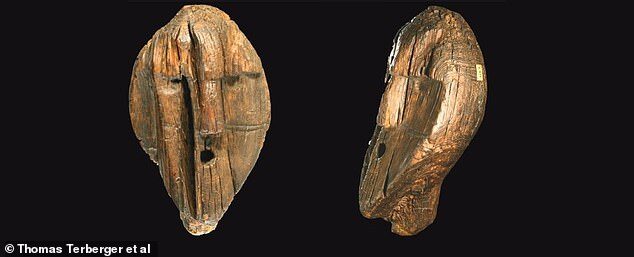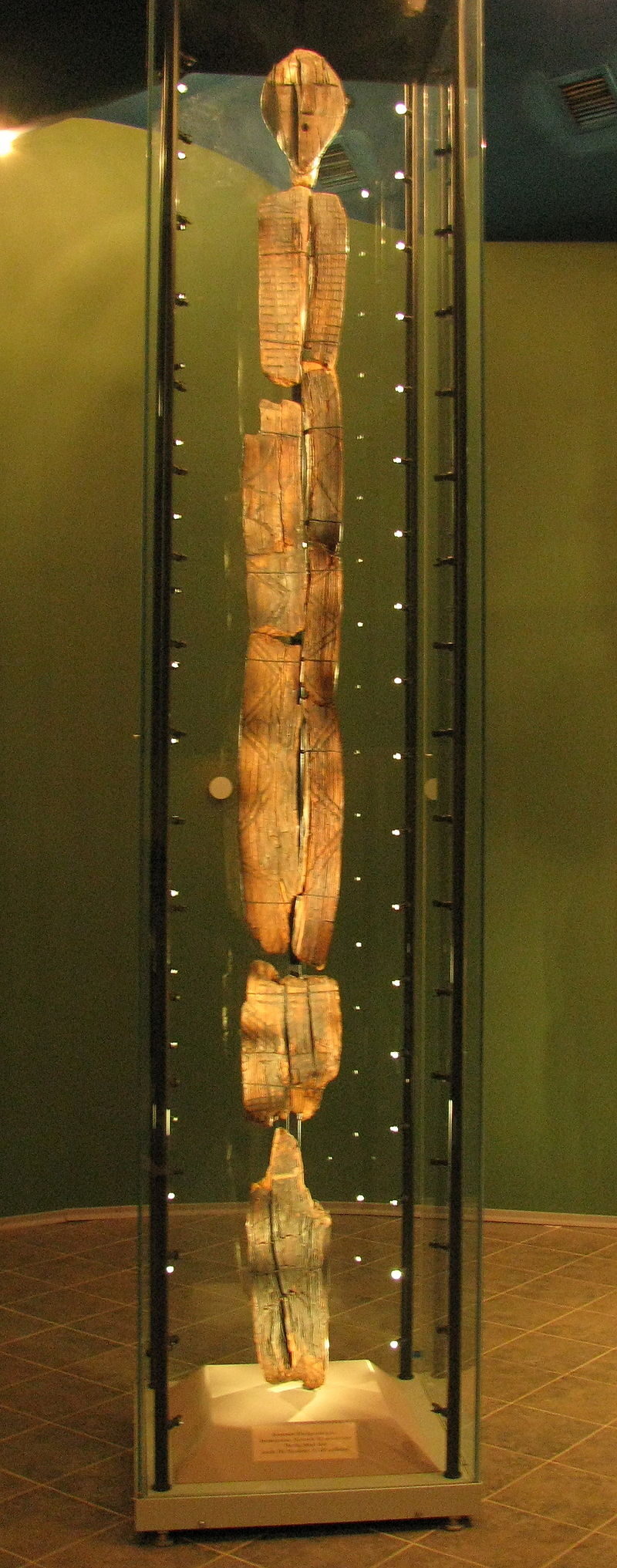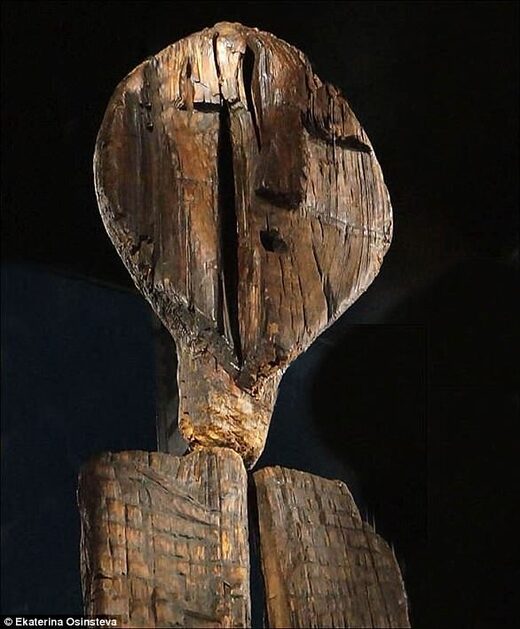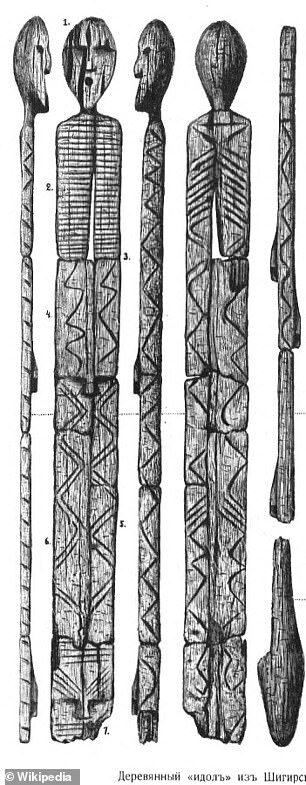The Shigir Idol was first discovered by Russian gold miners who stumbled upon the large object in the Shigir peat bog 62 miles north of Yekaterinburg.
Radiocarbon dating from the 1990s placed the idol at 9,750 years old, but researchers have since re-dated it, finding it is about 12,100 years old.
This makes it almost twice as old as Stonehenge in the UK, which had been dated back about 5,000 years.
The tree that provided the wood to carve the large statue was about 12,250 years old based on the 159 growth rings seen within the statue itself, the team from the University of Gottingen and Institute of Archaeology RAS discovered.
It is estimated it once stood over 17ft tall when fully assembled and has zig-zag lines etched all over the body, and eight human-like faces carved at the top.
The idol was in ten different pieces when it was first discovered in 1890 and discarded as a 'curiosity' to an earlier age - at the time it was impossible to say how much earlier that age actually was.
It had spent over 10,000 years preserved in the acidic antimicrobial environment of the peat bog, which is within the Ural Mountains in Russia.
The German and Russian team believe it was carved at the end of the last Ice Age and the start of the Holocene - the current geological period.
The period the idol was carved was an era of great climate change, according to archaeologist Thomas Terberger, speaking to the New York Times.
Comment: Indeed our planet has experienced catastrophic shifts in the recent past: The Seven Destructive Earth Passes of Comet Venus
It was a time when early forests were beginning to spread across a warmer late glacial to postglacial Eurasia.
'The landscape changed, and the art - figurative designs and naturalistic animals painted in caves and carved in rock - did, too, perhaps as a way to help people come to grips with the challenging environments they encountered.'
It was 'suggestive of an appreciation for art and craftsmanship' by the people who created it, the team behind the study explained.
It's more than twice as old as Egypt's famous pyramids, yet remarkably, much of the wooden sculpture has survived the years.
Some parts, however, have been lost and now the statue stands at just over 11 feet tall.
The sculpture was thought to have been made from a larch tree by ancient artists who used a polished stone adze and stone chisels of at least two or three different sizes to create its characteristic markings.
People who built the idol had the skills for shaping and carving wood, so while this is the only object of its kind discovered so far, that doesn't mean they didn't make more, the authors explained.
It adds to evidence that ancient hunter gatherer communities had a sense of art, ideas and complex rituals to an extent not previously understood, they said.
'We have to accept that hunter-gatherers had complex rituals and were capable of very sophisticated expression of ideas and art,' Terberger told the Guardian.
'These things didn't start with farmers, they began with hunter-gatherers much earlier.'
The findings have been published in the journal Quaternary International.
WHAT ARE THE MYSTERIOUS MARKINGS ON THE SHIGIR IDOL?
The Shigir Idol is covered in carvings, including what looks like code. The sculpture, known as the Shigir Idol, is now housed at the Sverdlovsk Regional Museum
Professor Mikhail Zhilin, leading researcher of the Russian Academy of Sciences' Institute of Archeology said: 'The ornament is covered with nothing but encrypted information. People were passing on knowledge with the help of the Idol.'
While the messages remain 'an utter mystery to modern man', the Russian academic said its creators 'lived in total harmony with the world, had advanced intellectual development, and a complicated spiritual world'.
Svetlana Savchenko, chief keeper of Shigir Idol at Yekaterinburg History Museum, concluded that 'a straight line could denote land, or horizon - the boundary between earth and sky, water and sky, or the borderline between the worlds.
'A wavy line or zigzag symbolised water, snake, lizard, or determined a certain border.
'In addition, the zigzag signalled danger, like a pike. Cross, rhombus, square, circle depicted the fire or the sun, and so on.'
But the marks could have multiple meanings for the ancient makers who gave the idol seven faces, only one of which is in 3D.
'Images on the front and back planes of the Idol, possibly indicate that they belong to different worlds.
'If there are depicted myths about the origin of humans and the world, the vertical arrangement of the images may reflect the sequence of events. Ornaments can be special signs which mark something as significant.'
Mr Savchenko argues that the idol tells the story of the 'creation of the world' as understood by Mesolithic man.







Comment: See also:
- 45,000 year old lion statuette found in Denisova Cave may be world's oldest
- The Existence of Female Shamans: Solving the Mystery of a 35,000-Year-Old Statue
- Mysterious 25,000-year-old circular structure built from bones of 60 mammoths discovered in Russia's forest steppe
- World's oldest cooking pots found in Siberia, created 16,000 years ago at the end of the last ice age
- Çatalhöyük: The 9,000 year old community troubled by climate change, over crowding and infectious diseases
- German archaeologist on the latest research at Gobekli Tepe
And check out SOTT radio's: